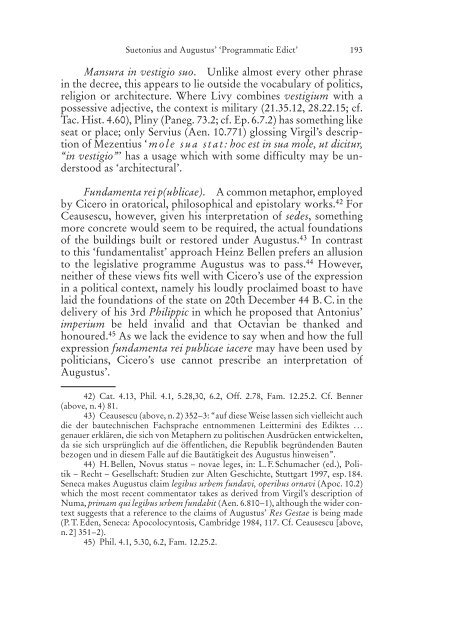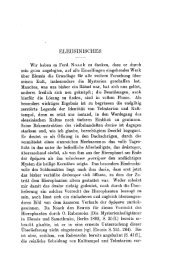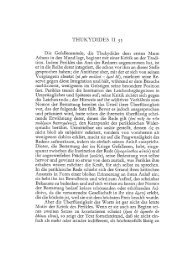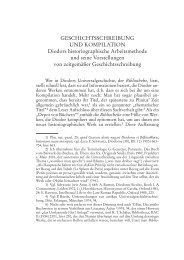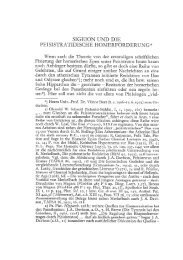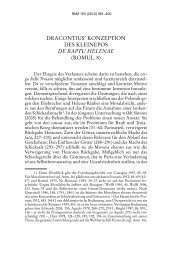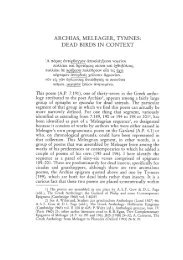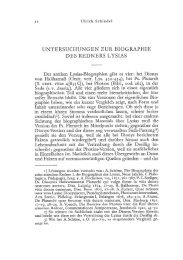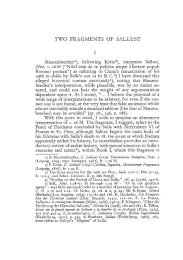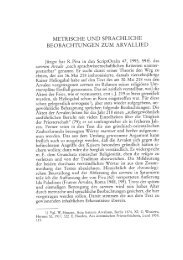VIRGILIO E STESICORO Una ricerca sulla Tabula Iliaca Capitolina *
VIRGILIO E STESICORO Una ricerca sulla Tabula Iliaca Capitolina *
VIRGILIO E STESICORO Una ricerca sulla Tabula Iliaca Capitolina *
Erfolgreiche ePaper selbst erstellen
Machen Sie aus Ihren PDF Publikationen ein blätterbares Flipbook mit unserer einzigartigen Google optimierten e-Paper Software.
Suetonius and Augustus’ ‘Programmatic Edict’<br />
Mansura in vestigio suo. Unlike almost every other phrase<br />
in the decree, this appears to lie outside the vocabulary of politics,<br />
religion or architecture. Where Livy combines vestigium with a<br />
possessive adjective, the context is military (21.35.12, 28.22.15; cf.<br />
Tac. Hist. 4.60), Pliny (Paneg. 73.2; cf. Ep. 6.7.2) has something like<br />
seat or place; only Servius (Aen. 10.771) glossing Virgil’s description<br />
of Mezentius ‘mole sua stat: hoc est in sua mole, ut dicitur,<br />
“in vestigio”’ has a usage which with some difficulty may be understood<br />
as ‘architectural’.<br />
Fundamenta rei p(ublicae). A common metaphor, employed<br />
by Cicero in oratorical, philosophical and epistolary works. 42 For<br />
Ceausescu, however, given his interpretation of sedes, something<br />
more concrete would seem to be required, the actual foundations<br />
of the buildings built or restored under Augustus. 43 In contrast<br />
to this ‘fundamentalist’ approach Heinz Bellen prefers an allusion<br />
to the legislative programme Augustus was to pass. 44 However,<br />
neither of these views fits well with Cicero’s use of the expression<br />
in a political context, namely his loudly proclaimed boast to have<br />
laid the foundations of the state on 20th December 44 B. C. in the<br />
delivery of his 3rd Philippic in which he proposed that Antonius’<br />
imperium be held invalid and that Octavian be thanked and<br />
honoured. 45 As we lack the evidence to say when and how the full<br />
expression fundamenta rei publicae iacere may have been used by<br />
politicians, Cicero’s use cannot prescribe an interpretation of<br />
Augustus’.<br />
42) Cat. 4.13, Phil. 4.1, 5.28,30, 6.2, Off. 2.78, Fam. 12.25.2. Cf. Benner<br />
(above, n. 4) 81.<br />
43) Ceausescu (above, n. 2) 352–3: “auf diese Weise lassen sich vielleicht auch<br />
die der bautechnischen Fachsprache entnommenen Leittermini des Ediktes . . .<br />
genauer erklären, die sich von Metaphern zu politischen Ausdrücken entwickelten,<br />
da sie sich ursprünglich auf die öffentlichen, die Republik begründenden Bauten<br />
bezogen und in diesem Falle auf die Bautätigkeit des Augustus hinweisen”.<br />
44) H. Bellen, Novus status – novae leges, in: L. F. Schumacher (ed.), Politik<br />
– Recht – Gesellschaft: Studien zur Alten Geschichte, Stuttgart 1997, esp. 184.<br />
Seneca makes Augustus claim legibus urbem fundavi, operibus ornavi (Apoc. 10.2)<br />
which the most recent commentator takes as derived from Virgil’s description of<br />
Numa, primam qui legibus urbem fundabit (Aen. 6.810–1), although the wider context<br />
suggests that a reference to the claims of Augustus’ Res Gestae is being made<br />
(P. T. Eden, Seneca: Apocolocyntosis, Cambridge 1984, 117. Cf. Ceausescu [above,<br />
n. 2] 351–2).<br />
45) Phil. 4.1, 5.30, 6.2, Fam. 12.25.2.<br />
193


